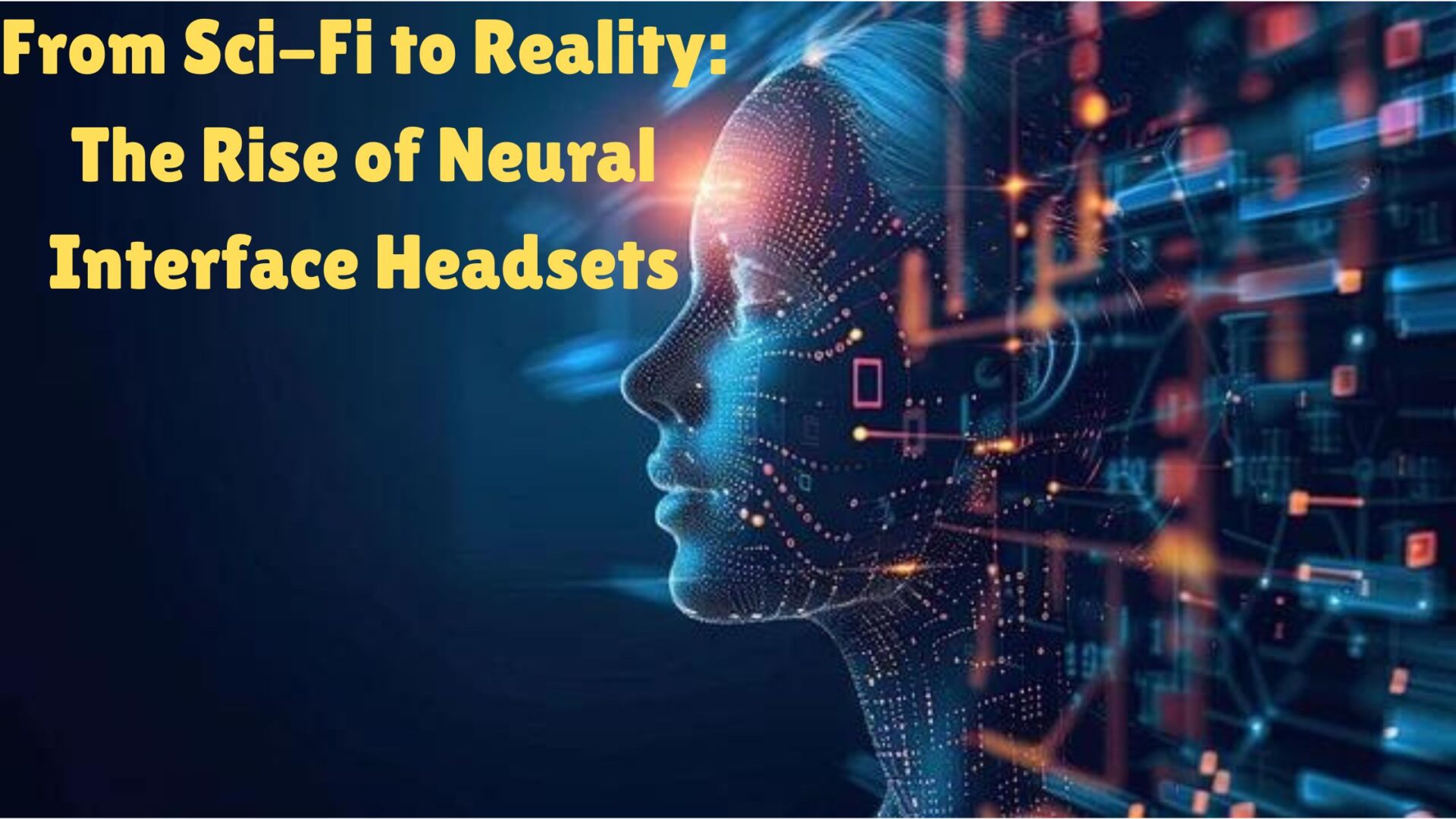Introduction:
From Sci-Fi to Reality: The Rise of Neural Interface Headsets

Imagine a world where you can operate devices solely through your thoughts or convey messages without uttering a single syllable. This vision, once relegated to the realm of science fiction, is now on the cusp of materialization owing to the advent of neural interface headsets. These revolutionary devices are redefining our interaction with technology, heralding a new era of communication, control, and seamless connectivity.
Neural Interface Technology Evolution
Neural interface technology has advanced from invasive BCIs in the 1970s to non-invasive headsets today, making it more accessible and safer.
How Neural Interface Headsets Work
Neural interface headsets detect and interpret brain signals, translating them into commands that control various devices, including computers, smartphones, prosthetic limbs, and smart home systems. The process involves several key components:
- Sensors: These high-tech components detect electrical activity in the brain, capturing signals associated with different thoughts and actions.
- Signal Processing: Advanced algorithms analyze these signals, identifying patterns that correspond to specific commands.
- Translation: The processed signals are converted into commands that devices can understand, enabling users to control them with their thoughts.
The Diverse Applications of Neural Interface Headsets
Neural interface headsets hold immense potential to revolutionize various industries and sectors.
Healthcare:

In healthcare, these headsets are transforming patient care. They provide mobility-impaired individuals with the ability to control wheelchairs and prosthetic limbs through brain signals, enhancing their independence and quality of life. Brain-computer interfaces (BCIs) are also aiding neurorehabilitation, helping stroke patients regain motor function through brain-controlled exercises.
Gaming and Entertainment:
The gaming industry is embracing neural interface technology. These headsets allow players to experience immersive gaming by interacting with virtual worlds using only their thoughts, eliminating the need for traditional controllers.
Communication:
Neural interface headsets offer new avenues of expression for individuals with severe communication impairments. By translating brain signals into speech or text, these devices provide a voice to those who cannot speak, empowering them to engage with others more effectively.
Smart Homes and IoT:
Neural interface headsets are poised to become integral to smart home technology. Imagine controlling lights, thermostats, and appliances with a mere thought. This seamless integration between brain and smart devices can enhance convenience and responsiveness.
Challenges and Future Prospects:
While the rise of neural interface headsets is encouraging, several challenges must be addressed. Ensuring the accuracy and reliability of brain signal interpretation is paramount. Concerns about privacy and security also require careful consideration. Additionally, making these devices affordable and accessible to a broader audience is crucial for widespread adoption.
Neural interface headsets have the potential to reshape our lives by providing innovative solutions to various challenges. As research and development continue, the future of this technology holds immense promise across diverse sectors.
What are the primary applications of brain-computer interfaces (BCIs) today?
Brain-computer interfaces (BCIs) enable direct communication between the brain and external devices. Here are the primary applications of BCIs today:

- Medical and Rehabilitation:
- Restoring Motor Functions: BCIs help individuals with spinal cord injuries, strokes, or other conditions regain motor control by allowing them to control prosthetic limbs, exoskeletons, or wheelchairs using brain signals.
- Communication for Locked-In Patients: Patients with conditions like ALS or severe paralysis can use BCIs to communicate by translating brain signals into text or speech.
- Neurorehabilitation: BCIs are used in therapies for stroke recovery, helping patients retrain their brains to regain lost functions.
- Neuroprosthetics:
- Cochlear Implants: These devices restore hearing to the deaf by bypassing damaged parts of the ear and directly stimulating the auditory nerve.
- Retinal Implants: These implants can partially restore vision for those with certain types of blindness by directly stimulating the optic nerve or retina.
- Mental Health and Cognitive Enhancement:
- Neurofeedback and Brain Training: BCIs are used for neurofeedback, helping individuals learn to control brain activity to reduce symptoms of conditions like ADHD, anxiety, and depression.
- Cognitive Enhancement: Experimental applications include enhancing memory, attention, and other cognitive functions through brain stimulation or training.
- Research:
- Neuroscience Research: BCIs provide a valuable tool for studying brain function and understanding neural mechanisms, allowing researchers to observe brain activity in real-time and understand how different brain regions interact.
- Gaming and Entertainment:
- Brain-Controlled Games: BCIs are used to create immersive gaming experiences where players can control in-game actions using their thoughts.
- Virtual Reality (VR): BCIs enhance VR experiences by enabling more natural and intuitive interactions within virtual environments.
- Assistive Technologies:
- Smart Home Control: BCIs enable individuals with disabilities to control smart home devices using brain signals.
- Environmental Control Systems: These systems allow users to control their environment, such as opening doors or operating computers, through brain activity.
- Education and Training:
- Skill Acquisition: BCIs enhance learning and skill acquisition by providing real-time feedback on brain activity and facilitating optimal learning states.
While many of these applications are still in the early stages, advancements in technology and neuroscience continue to expand the potential of BCIs across various fields.
What are the challenges in making neural interface headsets more user-friendly?
To make neural interface headsets more user-friendly, key challenges must be addressed:
Comfort and Wearability:
- Design adjustable, ergonomic headsets that fit various head shapes and sizes for long-term comfort.
- Reduce headset weight and bulk to prevent discomfort and fatigue.
Signal Quality and Stability:
- Ensure accurate electrode placement for high-quality signal acquisition.
- Maintain good skin-electrode contact despite user movement or skin conditions.
Ease of Use:
- Simplify setup and calibration processes to reduce the need for frequent recalibration.
- Develop intuitive user interfaces requiring minimal training.
Data Processing and Interpretation:
- Employ efficient algorithms for real-time brain signal processing, translating them into commands or actions.
- Ensure high accuracy and precision in interpreting brain signals using advanced signal processing and machine learning.
Power Supply and Battery Life:
- Extend battery life while keeping headsets lightweight and portable.
- Implement efficient power management to balance performance and battery consumption.
Durability and Maintenance:
- Design durable headsets that can withstand regular use and exposure to sweat, dust, and the environment.
- Reduce the need for frequent maintenance, such as cleaning electrodes or replacing components.
Privacy and Security:
- Ensure the privacy and security of brain data, especially as BCIs integrate into daily life.
- Address ethical concerns regarding brain data misuse and promote informed consent.
Cost and Accessibility:
- Make neural interface headsets affordable for a wide range of users, promoting widespread adoption.
- Ensure the availability of headsets and support services in regions with limited access to advanced healthcare technologies.
Collaboration among engineers, neuroscientists, designers, and user experience experts is crucial for developing neural interface headsets that are not only technologically advanced but also practical and user-centric.
Conclusion
- User-friendliness: Enhancing the user experience by reducing the frequency of maintenance tasks, such as cleaning electrodes or replacing components, can make BCIs more user-friendly.
- Privacy and Security:
- Data Privacy: As BCIs become more integrated into daily life, ensuring the privacy and security of brain data becomes a critical concern.
- Ethical Considerations: Addressing ethical concerns, such as informed consent, data ownership, and potential misuse of BCIs, is crucial to ensure the responsible development and use of these technologies.
FAQs
Q: Are neural interface headsets safe to use?
A: Yes, non-invasive neural interface headsets are designed to be safe and do not require surgical procedures. However, like any technology, they should be used as directed by manufacturers.
Q: Can neural interface headsets be used by anyone?
A: While the technology is advancing rapidly, neural interface headsets are currently more suited for specific applications and may require some training to use effectively.
Q: What are the potential risks of using neural interface headsets?
A: Potential risks include privacy concerns, as brain data could be sensitive. Ensuring robust security measures is crucial to protect users’ data.
Q: How soon will neural interface headsets become mainstream?
A: The timeline for mainstream adoption depends on continued advancements, cost reductions, and regulatory approvals. It may take a few more years before they become widely available.
Q: Can neural interface headsets help people with disabilities?
A: Absolutely. Neural interface headsets have shown great promise in assisting individuals with mobility and communication impairments, significantly improving their quality of life.
